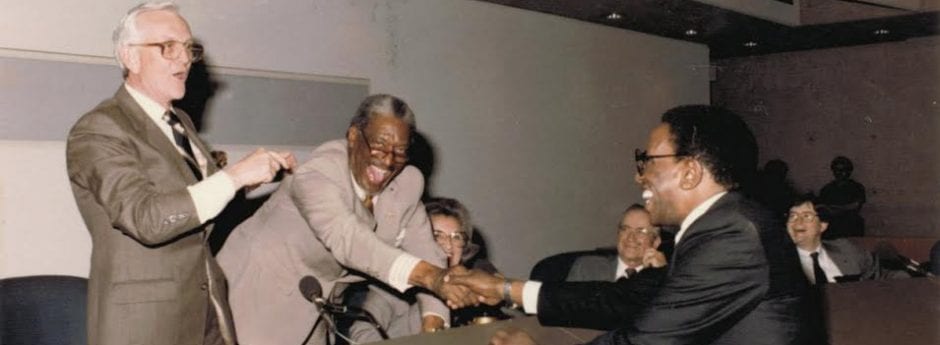
Roy H. Williams was known for his civic leadership and political activism in the Civil Rights Movement and the anti-apartheid movement in Dallas.
Williams was born in August of 1942 in Longview, Texas and began his civil rights activism as a teenager when he became president of the Longview National Association for the Advancement of Colored People (NAACP) Youth Council in 1959. During the civil rights movement of the 1950s it was at the forefront of the movement to find a legal confrontation that would lead to the civil and human rights of colored people being recognized. As part of his work with the NAACP, Williams participated in lunch counter sit-ins throughout East Texas, protesting segregation and advocating for equal rights. Williams’ involvement with the NAACP at such a young age showed his awareness of and care for activism- a passion that would influence many of his future actions.
During his youth, Williams attended Northeastern Junior College and then joined the United States Army. When he retired from the Army, he moved to Dallas in the 1970s and began his work in the city, attempting to advocate for the equal rights of minorities. Beyond advocating for local equality, Williams played a crucial role in convincing the city of Dallas to sever its ties with South Africa in an attempt to support the protests in that country against its apartheid policies. Williams, like many civil rights activists, became involved in the anti-apartheid movement as a result of his involvement with the civil rights movement in the United States. While civil rights slowly progressed in the United States, segregation seemed permanently institutionalized in South Africa, and American civil rights leaders like Williams hoped that American leadership could help to break apartheid’s hold on the South African black majority.
As part of his local activism, in 1983 Williams participated as treasurer and vice chair on the Police and Paramedic Complaints Committee. However, while he was in that position “he was a leading advocate for an anti-apartheid measure intended to sever Dallas’ ties with companies doing business in South Africa” (Simnacher). As a result of his advocacy work the Dallas City Council approved “an ordinance asking trustees of city retirement funds not to invest in companies that do business in South Africa or the Soviet Union” (Simnacher).
After this success, in 1987 Williams attempted, unsuccessfully, to run for a seat on the city council. “Williams said one of the obstacles he faced was convincing voters that he wanted to represent all of Dallas, not just its minority community” (Simnacher). As a result of the discrimination that Williams saw within the 8-3 voting system for the council, he became a co-plaintiff in the 1988 court case with Marvin Crenshaw, Williams v. City of Dallas.
Williams v. City of Dallas was a voting rights case concerning the 8-3 voting system for the election of members of the Dallas City Council. The 8-3 system that was in place referred to eight single-member districts and three “at-large” places. “Under this system, no African-American had ever been elected to one of the at-large seats” (The United States District Court). The lack of African Americans being elected to these at-large seats was largely due to the fact that many minority communities simply did not have the funds to support an effective campaign for their candidates. In 1990, the U.S. District Judge Jerry Buchmeyer struck down Dallas’ 8-3 system when he ruled that electing three seats on a citywide basis effectively took away the power of the minority vote. One year later in 1991 the first election with a 14-1 rule was held. The 14-1 rule allowed more minority representation on the city council because only the mayor was elected city wide and the 14 council members were selected from the community districts where they reside.
In recognition of his contribution to the city, in 1991 D Magazine selected Roy H. Williams as one of the 50 most influential activists in Dallas. The article describes how many citizens initially doubted Williams:
Once identified more as a kook than a legitimate political activist, Williams has come a long way in redefining his image. With Marvin Crenshaw, he brought suit against the city in 1988, an action that led to the at-large city council system being declared unconstitutional, paving the way for a council more racially inclusive than ever before. He also founded the Rainbow Bridge Youth Outreach Program. Williams is still considered quirky, with his daily meditation rituals and well-publicized gab sessions at La Madeleine on Mockingbird Lane, but his name is forever tied to a dramatic political change (Holston).
On March 18, 2017, Williams passed away in Dallas. However, he will always be remembered for his influential civil rights activism within the Dallas community and in making Dallas part of the anti-apartheid movement.
Works Cited
Holston, Bill, Nancy Nichols, Alex Macon, Dawn McMullan, and Michael J. Mooney. “50 People Who Made Dallas.” D Magazine. November 1991. Accessed April 25, 2017. https://www.dmagazine.com.
Simnacher, Joe. “Part of Suit Creating 14-1 Council.” Dallas Morning News. March 22, 2017. Accessed April 25, 2017. https://www.pressreader.com.
The United States District Court. “Williams v. City of Dallas | 734 F.Supp. 1317 (1990).” Legal. March 28, 1990. Accessed April 25, 2017. http://www.leagle.com.
